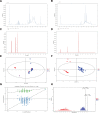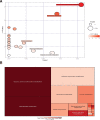Serum metabolomics analysis revealed metabolic disorders in Parkinson's disease
- PMID: 37335671
- PMCID: PMC10256383
- DOI: 10.1097/MD.0000000000033715
Serum metabolomics analysis revealed metabolic disorders in Parkinson's disease
Abstract
Background: Parkinson's disease (PD) is by now the second of the most prevalent neurodegenerative diseases in the world, and its incidence is increasing rapidly as the global population ages, with 14.2 million PD patients expected worldwide by 2040.
Methods: We gathered a completion of 45 serum samples, including 15 of healthy controls and 30 from the PD group. We used non-targeted metabolomics analysis based on liquid chromatography-mass spectrometry to identify the molecular changes in PD patients, and conducted bioinformatics analysis on this basis to explore the possible pathogenesis of PD.
Results: We found significant metabolomics changes in the levels of 30 metabolites in PD patients compared with healthy controls.
Conclusion: Lipids and lipid-like molecules accounted for the majority of the 30 differentially expressed metabolites. Also, pathway enrichment analysis showed significant enrichment in sphingolipid metabolic pathway. These assessments can improve our perception on the underlying mechanism of PD as well as facilitate a better targeting on therapeutic interventions.
Copyright © 2023 the Author(s). Published by Wolters Kluwer Health, Inc.
Conflict of interest statement
The authors have no conflicts of interest to disclose.
Figures



References
-
- Hatano T, Saiki S, Okuzumi A, et al. . Identification of novel biomarkers for Parkinson’s disease by metabolomic technologies. J Neurol Neurosurg Psychiatr. 2016;87:295–301. - PubMed
MeSH terms
Substances
LinkOut - more resources
Full Text Sources
Medical

